The more people take care of their health, the more popular fitness apps become. COVID-19 pandemic only accelerated this tendency. With less access to a gym, people are relying on virtual classes to keep fit.
If you see the opportunity in the current situation and want to know how to develop a fitness app, read our article. We will cover all the main information. I.e., the main types of fitness apps, their features, monetization strategies, and main building stages.
Table of Contents
- 1 Health and fitness apps market insights
- 2 What are the main types of fitness apps?
- 3 What features are needed to be included in your fitness app?
- 4 Main steps on how to build a fitness app
- 5 How can you earn money with your fitness app?
- 6 How much does it cost to create a fitness app?
- 7 What technologies to choose to make a fitness app
- 8 Tips and Tricks
- 9 Our expertise in fitness app development
Health and fitness apps market insights
Health and fitness apps’ market growth rapidly. Statistics only confirm this statement. For instance, in January 2019, Polaris Market Research published a study and presented a forecast that the size of the fitness app market will reach $14.7 billion by 2026, with a CAGR of 23% over the forecast period.
According to Statista, this 2020 alone, income in the fitness segment was $17,963 million and continues to grow rapidly. Moreover, revenue is expected to increase with a 2019-2023 CAGR of 5.0%, bringing the market size to $20,499 million by 2023. It means that the fitness app market continues to grow and is expected to expand in response to various health and fitness developments.

What are the main types of fitness apps?
To build a fitness application, first, you have to select its type. There are three main types of fitness applications. Let’s look through each of them:
- Activity tracking apps
This type can track various activities or exercises that the user chooses. Some of them are created especially for runners, cyclists, and exercise tracking depending on which action the customer selects. The app keeps track of the distance traveled, the number of steps taken, as well as the calories burned during exercise.
- Diet and nutrition apps
This type of application works as a tracking device for a specific function, such as eating habits. Users can log the food they eat, and the app helps keep track of how many calories are in the food they record. Water consumption can also be tracked using this app. A feature that can be useful for this type of application includes a barcode scanner that helps convey the nutritional information of selected food.
Food delivery app development: tips to save your budget and nerves
- Workout and exercise apps
This type of application serves as a personal trainer or mimics a gym or gym. It provides a specific training or exercise program to suit your fitness requirements, whether you want to gain muscle or just lose weight. Users can choose which part of the body they want to work on, such as the whole body, upper body, core strength, lower back, or even customize a specific workout.
These fitness apps offer different approaches to health and promote fitness that serves as a guide for everyone.
What features are needed to be included in your fitness app?
To make a fitness application, first, you need to choose the essential features. Let’s start with the most basic ones.
Basic features
Registration
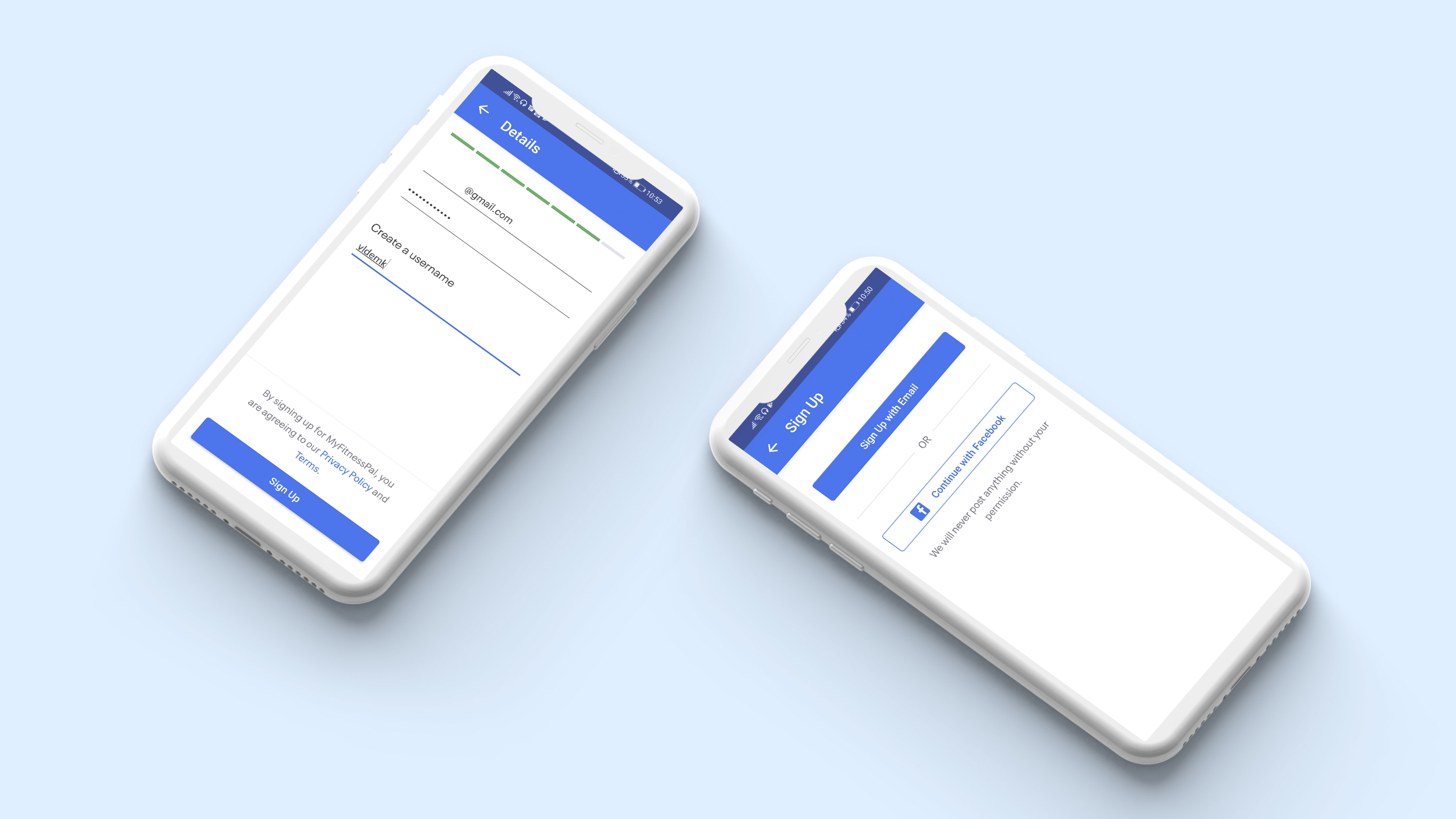
Registration feature is crucial for most applications. It may not be necessary if your app is a plain step tracker. However, if you provide unique training or nutrition plans, users should always register. Registration allows you to get more user data and make their interaction with the application more personalized.
User profile

Allow customers to manage their personal physical information. Even basic data like age, height, the weight will make the process of creating personal workouts easier. Thus, customers will achieve desired results faster.
Workout menu
The main goal of fitness apps is to track physical activity, so workout screens are a must. The menus may differ depending on the type of application, but the idea is the same. I.e., apps for smart fitness trainers will have a menu of workout options and a video explaining how to do the exercise. At the same time, the activity tracker app displays training time and session statistics in real-time.
- Statistics
Detailed statistics help customers understand their progress in case they don’t see visual changes. There are two types of statistics:
- Global
It displays global progress for the selected period (week, month, year). These statistics are useful for tracking changes in weight, muscle mass, and training intensity.
- Local
It is short-term statistics that help users track progress from one workout to the next. Local statistics show running cadence, distance traveled, heart rate, etc. Due to these statistics, athletes can track their performance during each workout.
Integration with third-party apps
To expand the app’s opportunities, you need to synchronize it with other workout and health apps. I.e, your application calculates the number of calories burned after the workout. In turn, a third-party diet app provides data on the meals customers consumed, and your app calculates daily calorie deficit or excess.
Integration with wearable devices
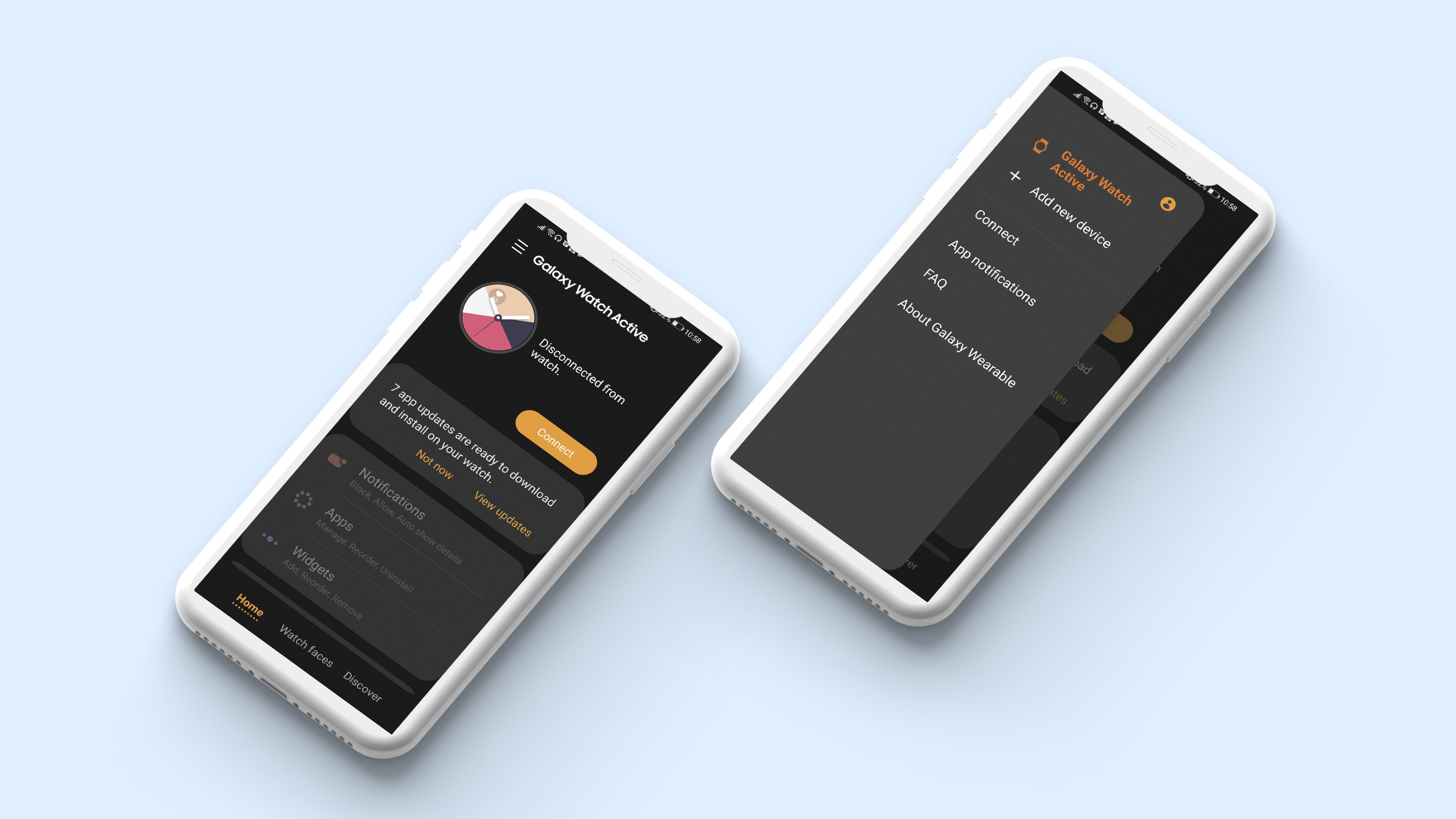
Such devices as fitness trackers, smartwatches, heart rate monitors, smart scales, and others provide even more statistics for your application. Besides, in the future, you can create a fitness app for wearable devices. Thus, users can leave their smartphones at home and get the same functionality on their smartwatches.
Fitness database
Regardless of the type of application, it must have a large fitness database. If you’re building a diet app, give users the ability to choose foods they can add to their diet. If they can’t find a specific dish in your application, they will probably give it up and start looking for alternatives.
The same story with developing a workout app. Apps should offer a wide variety of exercise choices, explain their effects on the body, and clearly state how many calories users will burn during the workout. A large database of exercises is imperative so that users can work with different muscle groups and create a variety of training plans. If your app doesn’t have enough content, it will be difficult to retain users.
Standard features
Setting goals
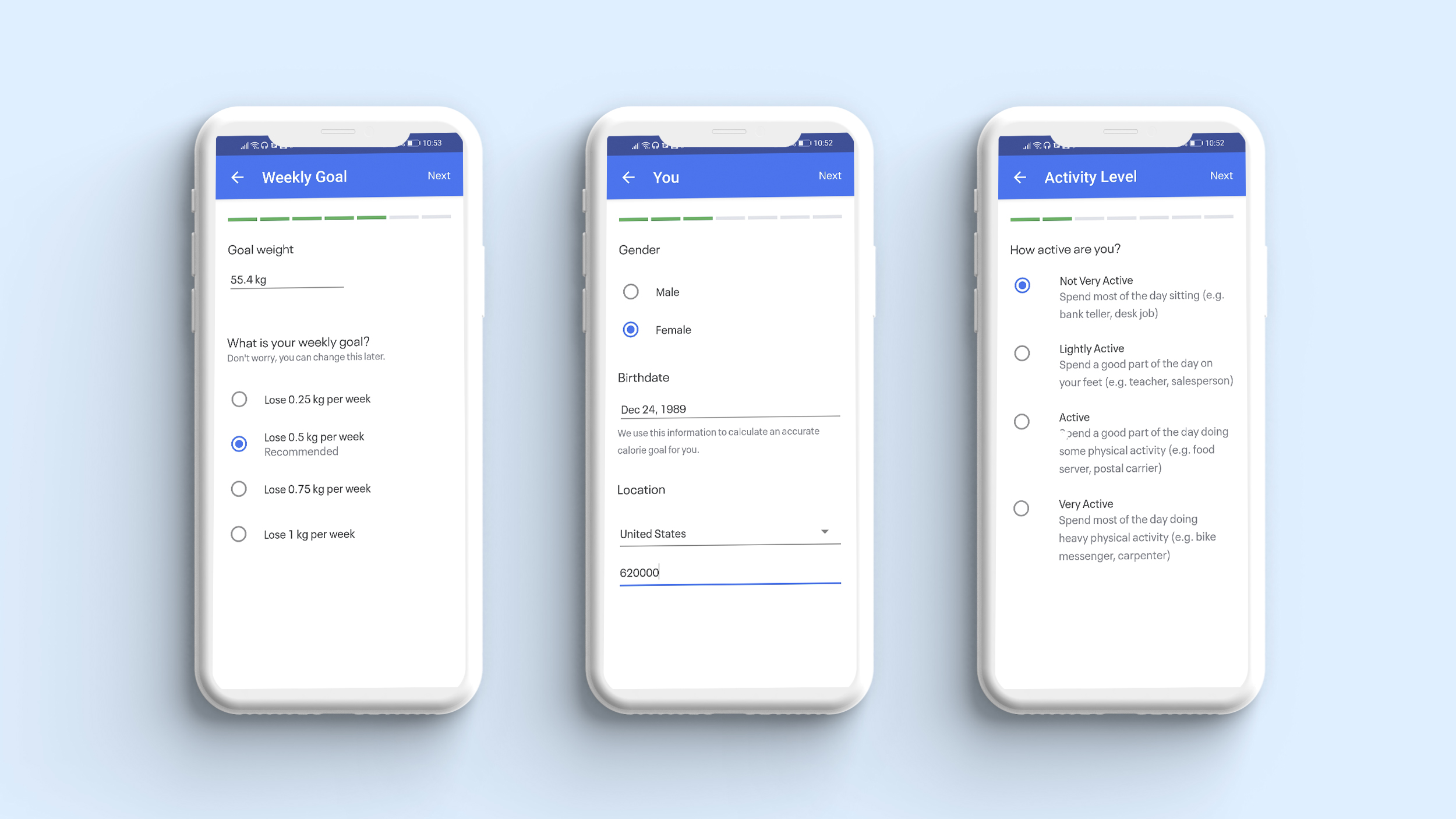
If you’re going to build a fitness app, you need to understand that one of its primary goals isn’t just to provide people with tracking tools or video guides. It is equally important to encourage users to exercise regularly. And it will be more difficult for them to abandon your application if they can set specific goals and track progress.
Educational content or video tutorials
Providing educational content in the app, such as tips on how to stay fit and healthy, methods to improve thinking while playing sports, and even exercise instructional videos, will keep users engaged.
Integration with social networks
Adding social media functionality to the app gives your app free advertising as users can share their results on their social media pages. It’s also important to make sure your app has social media pages so people can easily see what the app is when grabbing attention.
Killing features
Gamification
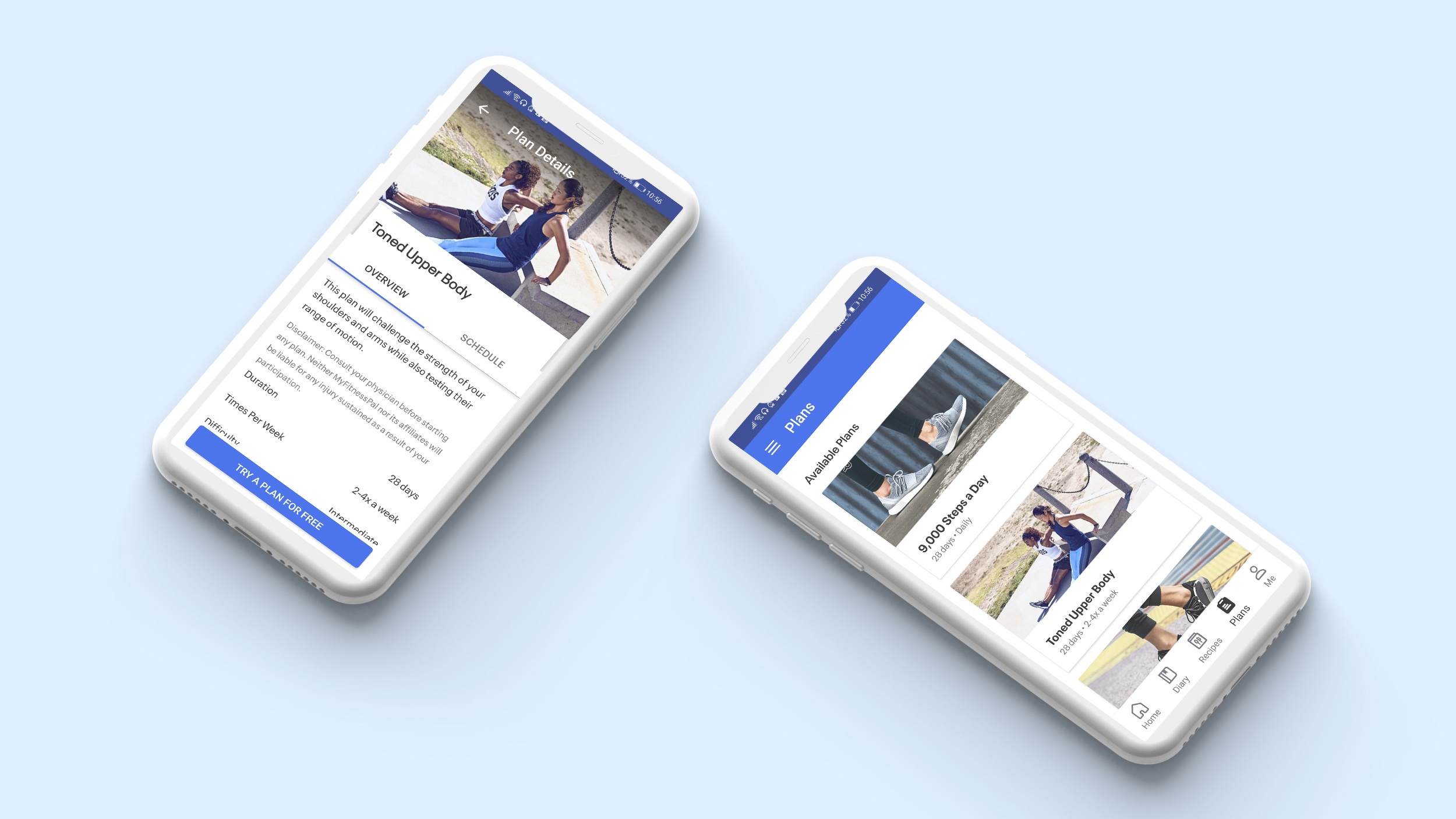
This feature creates additional motivation for users and prevents them from stopping using your application. Rewards, badges, and competition elements give users a strong sense of purpose and motivation.
Streaming
If you want to create a gym app, you will need to enable the class streaming feature. However, all of these functions must be combined into a single gym program.
All features, both basic and unique, must be taken into account to ensure the best health outcomes for the users of the application. The features listed above are essential to keep your fitness app up to date in the long term.
Main steps on how to build a fitness app
So, you decided to build your fitness application. It means it’s time to briefly overview the development process.
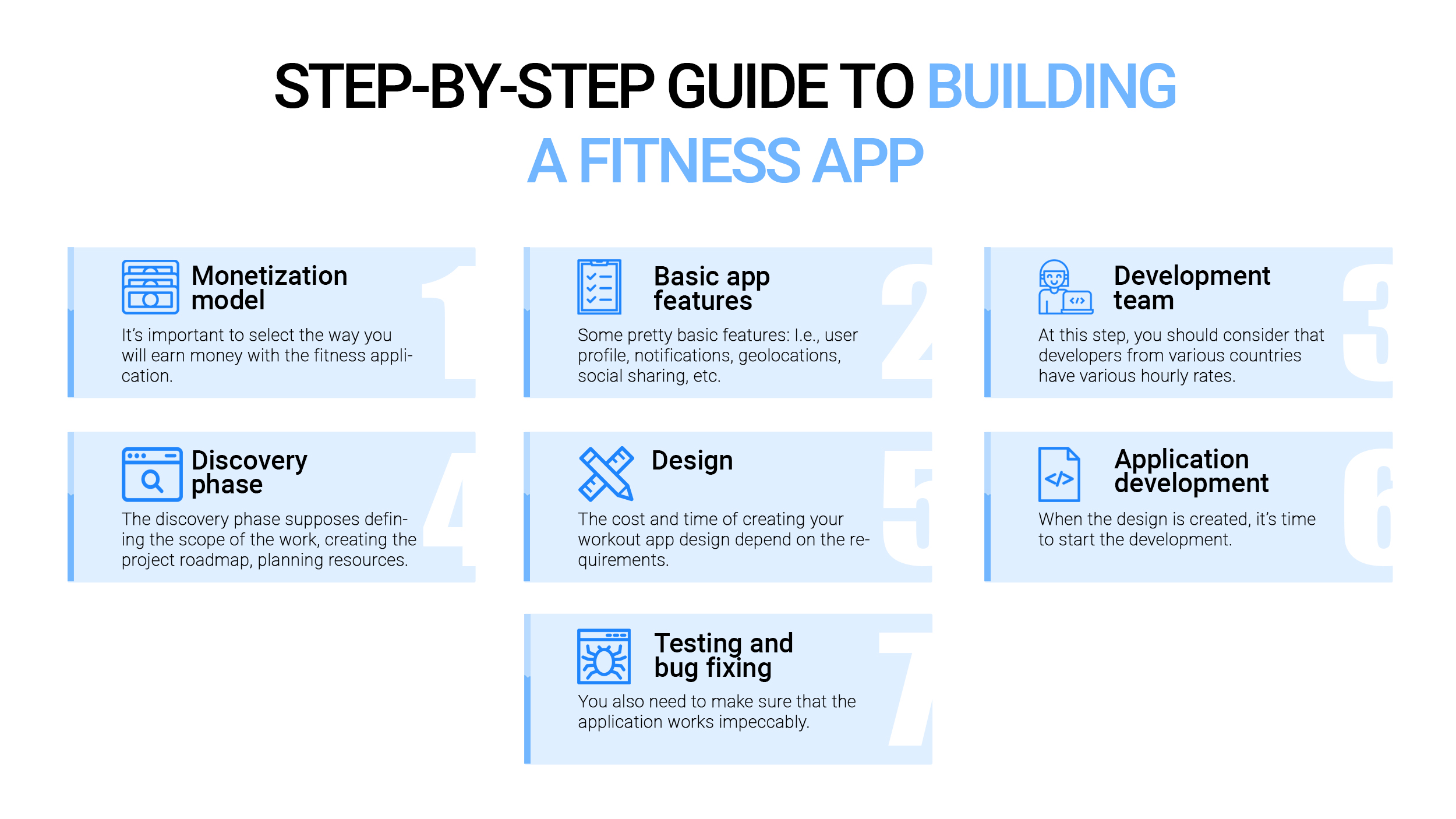
- Choose the monetization model
Before you start the development process it’s important to select the way you will earn money with the fitness application. There are several main models: paid apps, in-app purchases, freemium, ads, sponsored content. We will consider each of them below in the article.
- Consider basic fitness app features
Of course, each application has some unique features. But some pretty basic features are presented in all fitness apps. I.e., user profile, notifications, geolocations, social sharing, etc.
- Hire a development team
It’s impossible to build an app without a development team. At this step, you should consider that developers from various countries have various hourly rates. Thus, the programmers from the US and Australia earn around $110/hour, programmers from Western Europe charge in average from $80/hour, and their colleagues from Eastern Europe have about $50/hour
- Discovery phase
The discovery phase supposes defining the scope of the work, creating the project roadmap, planning resources, and setting the MVP budget. The phase takes from 4 to 6 weeks. Moreover, it includes functional specification development, UX/UI design, and visual prototyping of your application to give you a clear idea of the final product.
- Design
The cost and time of creating your workout app design depend on the requirements. I.e., you may only need standard features or some custom details.
When the design is created, the features, functionality, and monetization model are chosen it’s time to start the development.
- Testing and bug fixing
It may seem that the development stage is the final step. But you also need to make sure that the application works impeccably. So, QA engineers have to check the code and fix all the bugs.
Now, when you know everything about the process of application development we can move on to the main monetization models.
How can you earn money with your fitness app?
There are several ways to make a profit from the fitness application. Here is a list of the main of them:
- Paid apps
The most simple and common model. It supposes that users have to pay just once when they are downloading the app. The price may vary depending on the type of application, platform, and content you share.
- In-app purchases
Do you want to make the application free for customers but at the same time earn money? So, in-app purchases are a good option. You may offer everything starting from recipes and ending with premium content from star coaches.
- Freemium
Freemium means that your application’s users receive access to basic features for free. But if customers want to use the premium features, they have to pay.
- Advertisements
The good variant is to cooperate with the other fitness project and let them run ad campaigns in the application. You can charge a cost-per-click or a cost-per-mile commission.
- Sponsored content
It supposes partnerships with fitness gurus and gyms. Your partners can share valuable content through the app and enrich your app with customers’ experiences.
- Combined
You can combine multiple models to get a higher profit. I.e., if your app displays ads, users can remove them with a paid subscription. This way, you will make money from both unsubscribed users and premium users.
It is difficult to find an application that does not use the combined model. The main advantage of a subscription is that users get rid of ads. Almost every company understands this and uses it to its advantage.
How much does it cost to create a fitness app?
It’s difficult to estimate the cost of a fitness app precisely. The final price depends on the complexity of the idea, the number of development hours, and the development team structure. Thus, an MVP (minimum viable product) may cost around $25,000-$30,000. A full-featured project price may vary from $60,000 to $160,000. Everything depends on whether you need to implement AI/ML technology, support BLE and different hardware connectivity, or include voice integration and video streaming, etc.
What technologies to choose to make a fitness app
Functionality determines the choice of technology required to build a fitness app. Whether it’s creating running routes or posting your badges on social media, the technical side of these features requires third-party integration.
Here is a list of the integrations you might need to build a fitness application, and a brief description of them:
| Integration | Description |
| Google Maps Android IP
MapKit (iOS) |
Creating routes for jogging or cycling |
| Google Location API (Android)
Core Location (iOS) |
Needed to implement geolocation feature |
| Google Places API | Refers to information about geolocation, and points of interest |
| Google Directions API | Used to calculate the distance between points |
| Twilio Communications | Used to send notifications via short messages (SMS) |
| Google Cloud Messaging (Android)
Apple Push |
A service to send notifications to Android or iOS devices |
| ELCIES Connected Services | Collects data from wearables |
| Stripe
PayPal’s SDK Apple Pay |
These services allow building a fitness app with a payment gateway |
| Walgreens Balance Rewards | Enables reward points for different activities |
| FitBit Friends API | Sends friend requests within a community, gets a friends leaderboard |
Besides, very often conduct personal research on how to create a fitness application technically to know what competencies to expect from the development team.
Here is a list of technologies that are best suited for developing fitness applications:
| Side | Description |
| Front-end (client-side) | HTML 5, CSS3, JavaScript, Angular js, Vue.js – for web client
Kotlin – for Android client app Swift – for iOS client app |
| Back-end (server-side) | Ruby (Ruby on Rails framework), Phoenix (elixir framework) |
We hope the above information has given you some insight into how to build a fitness app from a technical standpoint.
Tips and Tricks
With extensive experience developing mobile fitness apps, we can recommend a few things that will make your app astonishing. Here they are:
Test the application from the usability point of view
Users from the target group can notice plenty of things that your QA engineers may be unaware of. I.e., they need longer time between sets, etc.
Use TomTom
TomTom is a service that provides real-time maps and traffic data, with global coverage & advanced functionalities. It significantly improves UX.
Implement HealthGraph API
HealthGraph API is needed to track all customers’ activities. Like sleep, nutrition, weight, completed strength training, etc.
Don’t connect your app to hardware sensors of smartphones
It’s much easier to use SDK’s and API’s of Google Fit (for Android) and Apple’s HealthKit (for iOS) to get all the basic tracking statistics.
Our expertise in fitness app development
At Code&Care, we’ve succeeded enough to work on several fitness projects. The last one is Dojanga. It is some kind of social network for people who are passionate about taekwondo. The application allows users to create their training planner, learn techniques, improve their fitness, mobility, and strength to fire up those kicks. It includes free and paid options.
Dojanga is based on Micco’s (founder) vision. We met his expectations by implementing sophisticated business logic and making everything work with AWS. During the development process, we used such technologies as PHP, Yii, jQuery, HTML 5, CSS 3, Bootstrap, MySQL, AWS.
To get a professional opinion about your idea, send us a quote: [email protected]. And we will consult you for free on a cost estimate of your project.

How to Make a Video Calling App Like Zoom and Google Hangouts?
How to Build a Rideshare App: Types, Features, Cost and Challenges
Progressive web application development: Cost, Tech Stack, Advantages
Web Application Development Cost: The Full Guide On Your Project Price
















Popular
Latest